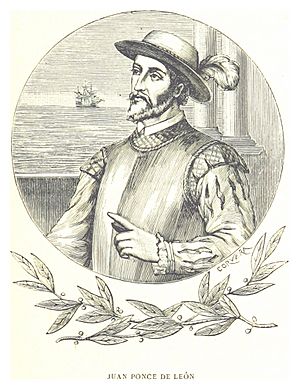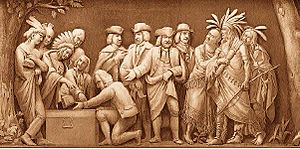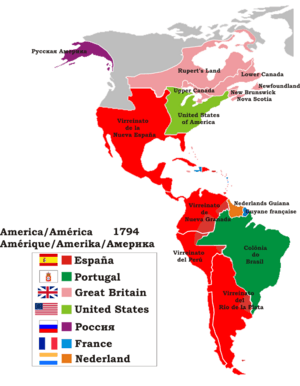European colonization of the Americas facts for kids
The European colonization of the Americas began long ago, even before Christopher Columbus arrived. Around the year 1000, Vikings from Scandinavia (northern Europe) sailed to what is now Newfoundland. They built a settlement called Vinland, but they eventually left.
In 1492, Christopher Columbus arrived in the Americas. Soon after, many Europeans, including Spanish conquistadors (explorers and conquerors), came to settle. Different European countries claimed different parts of the land and often fought over them. Sadly, many Native people died from diseases or conflicts. Those who survived lost most of their land and often had to learn the language of the Europeans who took over.
After many wars in the late 1700s and early 1800s, most of these colonies became independent countries.
Contents
Exploring the "New World"
In the 1300s and 1400s, people in western Europe wanted to find new ways to trade with places like India and China. The old routes for spices and other goods were very long and dangerous. Also, merchants who controlled these routes charged very high prices.
Some geographers (people who study the Earth) believed the world was small enough that ships could sail west across the Atlantic Ocean to reach East Asia. A sea captain from Genoa, named Christopher Columbus, convinced Queen Isabella of Spain to pay for his journey.
Columbus's First Voyage
In August 1492, Columbus left southern Spain with three ships: the Nina, Pinta, and Santa Maria. After many weeks at sea, on October 12, they reached an island in the Bahamas. Columbus named it San Salvador. He thought he had reached islands near India, so he called the local people "Indians."
Columbus then explored more of the Caribbean Sea, including Cuba, where he saw people smoking tobacco. He then sailed back to Spain, where the King and Queen gave him many honors.
Later Voyages and New Settlements
On his next trips, Columbus brought more people, including missionaries who wanted to spread Christianity. The ships also carried farm animals and supplies to start new colonies. He helped create a new settlement on an island that is now the Dominican Republic.
After a while, Europeans realized they had found a "New World" instead of a new way to Asia. The main goal for Spain became taking control of these new lands. Spanish conquistadors had permission from the Queen to explore and conquer.
Spanish Conquests in the Americas
Spanish conquistadors, with only a few hundred soldiers, managed to defeat large Native American empires. In 1519, Hernán Cortés and his soldiers marched into the capital of the Aztecs. They eventually destroyed the city, which was later rebuilt as Mexico City. Francisco Pizarro was able to conquer the Inca Empire in South America.
The Spanish won for several reasons. Some Native people thought the Spanish were gods. They were also scared of the horses and guns the Spanish brought. Plus, different Native groups sometimes fought among themselves, which the Spanish used to their advantage.
European Nations Colonize


Spain and Portugal were the first European countries to colonize large parts of South America and Central America in the 1500s. They also claimed some areas in North America. In the next century, people from other European countries came to the Americas. They mostly settled in North America because Spain and Portugal already controlled the warmer southern regions.
France and England were the most successful in these later colonies. England took control of the middle part of eastern North America. France claimed lands further north. Eventually, the English colonists took over most of the French territory in North America.
English Colonies
The English people who settled in the southern colonies first looked for gold. However, they found good soil, which allowed them to grow cash crops, especially tobacco. These crops were grown to be sold for profit.
The English settlers in the northern colonies, like New England, couldn't grow these crops as easily. Many of them were Puritans who wanted religious freedom from the Anglican Church back home. The Middle Colonies were more focused on trade. They traded furs and grew food for themselves, other English colonies, and later for export back to England.
Spanish and Portuguese Colonies
The Spanish settled in Central and South America. They mined for gold and silver and farmed tobacco. The Spanish had a lot of labor because they used Native people to do the work. This system was called Encomienda. In some places, this system led to the deaths of too many Native people. So, the Spanish began to import slaves from Africa.
The Portuguese grew a lot of sugar and other tropical cash crops in Brazil. They also brought many Africans to work as slaves on these plantations. Portugal became the biggest buyer in the Atlantic slave trade.
French Colonies
France had colonies in the Caribbean and also in the northern part of mainland North America, which they called Canada. In the north, they were looking for a Northwest Passage, a sea route to Asia. French Canada had a small population, so the French often worked with Native people to survive.
The French made a lot of money from the fur trade until they lost Canada in the French and Indian War. The French Caribbean colonies were warm and good for farming, so they bought many slaves for their plantations there. French Canada, however, had poor farmland and did not use slaves.
Related pages
Images for kids
-
The Discovery of America (Johann Moritz Rugendas).
-
The silver mountain of Potosí, in what is now Bolivia. It was the source of vast amounts of silver that changed the world economy.
-
New Amsterdam on lower Manhattan island. It was captured by the English in 1665 and became New York.
-
Triangular trade between Europe, Africa, and the Americas.
-
African slaves working on a tobacco plantation in Virginia, around 1670.
-
Castas painting showing a Spaniard and a mulatta spouse with their morisca daughter by Miguel Cabrera, 1763.
-
Puerto Plata, Dominican Republic. Founded in 1502, it is the oldest continuously-inhabited European settlement in the New World.
-
Cumaná, Venezuela. Founded in 1510, it is the oldest continuously-inhabited European city on the mainland of the Americas.
See also
 In Spanish: Colonización europea de América para niños
In Spanish: Colonización europea de América para niños
















